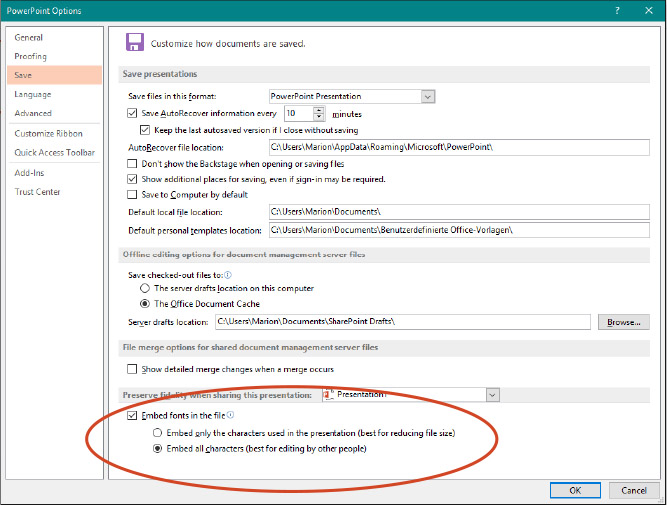How to embed fonts in PowerPoint
Do you remember or have you heard of WYSIWYG ‒ what you see is what you get? When creating a presentation on your computer you can immediately see what it looks like. Yet the whole thing can look completely different when you open your presentation on a different device. WYSIWYG can then quickly become WYSINAWYG: What you see is – not always – what you get.
Broken formatting
Your presentation looks beautiful. All texts are arranged nicely, everything’s looking great in the corporate design. Then you forward it to someone, or you open the presentation on another device, and a nightmare unfolds: The slides look terrible! Why? Because a particular device didn’t have the necessary fonts installed and therefore used a default one instead. This can cause all your carefully constructed formatting, content positioning, sizing and charts to be completely shot to pieces. You may not even notice this as the major cause of this minor disaster as the font box at the top insists your chosen font is being displayed – even though it’s not. This is really mean, especially if you try to solve the issue with another person to identify what went wrong.
Embedded fonts prevent formatting errors

As always, there’s a cure available for this ailment. If you didn’t select a standard Windows font, perhaps because of corporate design requirements, then cover yourself and embed your intended font. It’s relatively simple:
Under File, click on Save As, select Tools, click on Save Options, and tick the box next to Embed Fonts in File, then click OK. This works relatively reliably with True Type and Open Type fonts.
As you can probably tell by the word “relatively”, there are nevertheless a few more things you should be aware of:
- Your file will increase in size, usually by at least 1 MB.
- Check that your chosen font can be embedded.
- PowerPoint Mac recognizes embedded fonts only from version 2016 (16.11) onwards.
- Remember to actually carry out the Embed Fonts procedure!
Optimal font control
Play it safe by sending your presentation in PDF format. This is very effective if it goes to a recipient to whom only the content is important – e.g. if your presentation is intended to serve as a handout or a working paper. If, however, the recipients would actually like to use your presentation as such, then a PDF file will severely limit that purpose. None of the dramatic effects through animations will be possible, unless you create an individual slide for each step of the animation. Which is certainly the least efficient way of going about things.
If you’d like to use a font which is non-standard in Windows as a corporate font, the best solution would be to differentiate between print application and Office application in corporate design, and then agree to use a font similar to the corporate font for all Office applications (since this problem is not confined to PowerPoint). Rest assured this is usually possible. It should, however, always be coordinated by your company’s marketing department.
If you observe these small suggestions, you can be sure that the “NA” will only stand for “not applicable” regarding any font problems in your presentations.